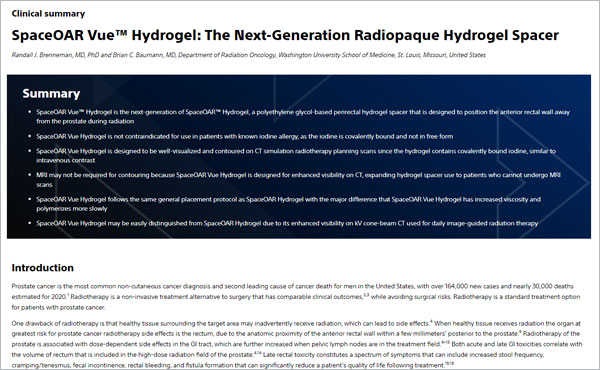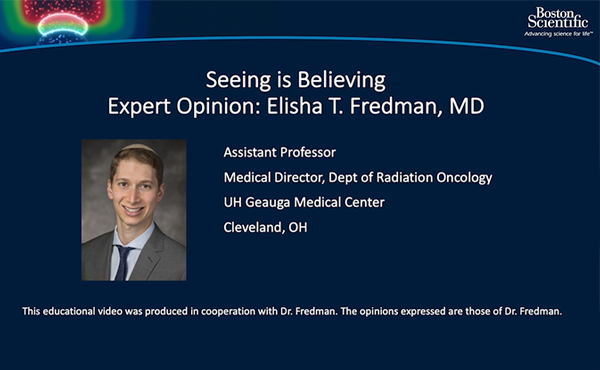Boston Scientific accounts are for healthcare professionals only.
Editorial commentary
As a radiation oncologist, I use multiple strategies in my practice to mitigate long-term rectal toxicity in prostate cancer patients. One patient, a doctor himself, with ulcerative colitis, approached me about six years ago requesting that I treat his cancer and that I use a SpaceOAR Hydrogel spacer as part of his treatment. This request was the impetus for bringing it into my practice. Since then, I’ve found that using a rectal spacer — specifically an iodinated spacer (SpaceOAR Vue™ Hydrogel) — provides numerous advantages, including improved contouring accuracy, which helps to reduce the radiation dose delivered to the rectum, thus minimizing impact to the rectum.1–3
In my experience with rectal spacers, the hydrogel and soft tissues, such as the prostate and rectum, have similar radiodensities. This sometimes makes it difficult to visualize on a CT scan, thus making contouring more challenging. For optimal delineation of critical tissues, a treatment planning MRI is suggested. Image registration and fusion of the CT scan and MRI is inherently challenging, which can lead to uncertainties in the gel interface with the prostate and rectum.
However, when using an iodinated spacer, I have found that the iodine makes it easier to differentiate the prostate and the rectum making the fusion of the MRI and CT scans more straightforward. An iodinated rectal spacer such as the SpaceOAR Vue, is readily visible on a CT scan and this improves target coverage, particularly posterior target coverage, which in turn helps us ensure reduced radiation dose delivered to the rectum.1 In my practice, I have also found SpaceOAR Vue is easy to place with a low chance of clogging the needle, and the absorption profile is approximately six months.
Contouring approach
Every radiation oncologist contours in their own way. I believe it’s more of an art than a science. But, in my opinion, there’s no question that contouring the prostate precisely is a critical step during treatment with radiation therapy.4 Proper contouring can lead to better patient outcomes by reducing the chance of rectal toxicity.5
When my team is treating a patient with stereotactic body radiation therapy (SBRT), the first step is putting gold markers in the prostate simultaneously with the SpaceOAR Vue placement. The second step is getting a treatment planning MRI and a treatment planning CT scan and fusing them together. Then I take those scans and program the computer to administer the dose to the prostate without overdosing the rectum, the bladder and the penis.
I’ve contoured approximately 2,000 patients over the past 15 years. With first-generation, non-iodinated spacers, I needed about 60 minutes for contouring, which included entering targeting details in the computer. However, now that I am using the SpaceOAR Vue in my practice, I have found that it improves visibility on CT, thus simplifying the fusion process and making it more efficient. It has also cut our contouring process time in half — maybe even more — and has reduced the fusion inaccuracy.1 It’s also important to note that, because the gel is iodinated, the SpaceOAR Vue can be seen on cone beam CT when aligning the patient within the radiation machine during daily treatment.1
Dose escalation and contraindications
The optimal rectal dose constraints for patients with a rectal spacer undergoing conventional fractionated radiotherapy, moderately hypofractionated radiotherapy or SBRT are currently unknown. I believe that, at a minimum, typical dose constraints used in non-spacer patients should be easily achievable with placement of a spacer and should allow for safer dose escalation. At least that has been my experience. One frequently employed strategy I use to aggressively manage rectal dose is to contour the spacer itself as part of the rectal contour.
Since iodinated rectal spacers are readily visible on a CT scan, I have found in my practice that this allows for improved delineation of target volumes and organ at risk (OAR) dose calculations. But if image registration and fusion are even slightly off, it could lead to uncertainties in the gel interface with the prostate and rectum, as well as inaccuracies in target and OAR dose calculations.
The SpaceOAR Vue is particularly helpful for patients who are unable to get a treatment planning MRI, due to implanted metallic devices.1 Contouring without an MRI can be very challenging and increases the likelihood of underdosing the prostate or overdosing the rectum. However, when there is an iodinated spacer between the prostate and the rectum, I find it’s easier to delineate the rectum, the spacer, and the prostate which, again, is essential for correct dosing.1
However, if there is a presence of posterior extracapsular extension between the prostate and the rectum, I would not consider using SpaceOAR Vue. But this is uncommon in most patients.
Patient outcomes and insights
While, in general, long-term survival rates are excellent in prostate cancer patients treated with definitive radiotherapy, some patients do experience late effects of radiotherapy that can be difficult to manage.6 The data suggests that the use of a spacer helps minimize bowel side effects in these patients.3 And in my practice, we’ve very clearly seen the additional benefit of improved quality of life when using a hydrogel spacer, and particularly the iodinated hydrogel spacer.1,2
My team is very thorough about following up with all 2,000 of my patients. We inquire about subtle details — such as the unexpected urge to use the bathroom. We want to know about anything that impacts their quality of life. Being able to track their experience, even when it includes toxicity, has been essential in helping me refine my practice to ensure patients are getting the best care. In fact, I continue to follow up with the doctor who requested I treat him with a spacer and I’m happy to say that he’s doing well. He’s six years out from treatment now. His PSA is very low and he’s had no undue side effects. He’s very happy with that outcome and I'm grateful that his request resulted in me helping hundreds of other patients in similar situations.
Conclusion
While contouring is very much a personal approach for physicians, I’ve found that contouring with an iodinated spacer makes my job easier. In my experience, contouring with an iodinated spacer provides both physicians and patients with benefits, including improved accuracy during contouring, saving my time, all while minimizing impact of radiation on the rectum.3
Related content
References
- Data on file with Boston Scientific.
- Hamstra DA, Mariados N, Sylvester J, et al. Sexual quality of life following prostate intensity modulated radiation therapy (IMRT) with a rectal/prostate spacer: secondary analysis of a phase 3 trial. Pract Radiat Oncol. 2018;8:e7–e15.
- Mariados N, Sylvester J, Shah D, et al. Hydrogel spacer prospective multicenter randomized controlled pivotal trial: dosimetric and clinical effects of perirectal spacer application in men undergoing prostate image guided intensity modulated radiation therapy. Int J Radiat Oncol Biol Phys. 2015;92:971–977.
- Lin D, Lapen K, Sherer M, et al. A systematic review of contouring guidelines in radiation oncology: analysis of frequency, methodology, and delivery of consensus recommendations. Int J Radiat Oncol Biol Phys. 2020;107:827–835.
- Gross A, Yuan J, Spratt D Fredman E. Case report: role of an iodinated rectal hydrogel spacer, SpaceOAR Vue™, in the context of low-dose-rate prostate brachytherapy, for enhanced post-operative contouring to aid in accurate implant evaluation and dosimetry. Front Oncol. 2021;11:810955.
- Survival Rates for Prostate Cancer. American Cancer Society. https://www.cancer.org/cancer/prostate-cancer/detection-diagnosis-staging/survival-rates.html. Accessed June 29, 2022.
Sean Collins, M.D., is a Boston Scientific consultant and was compensated for his contribution to this editorial. Statements made represent the opinion and experience of Dr. Collins. Results from case studies are not necessarily predictive of results in other cases. Results in other cases may vary.
Caution: U.S. Federal law restricts this device to sale by or on the order of a physician.
CAUTION: The law restricts these devices to sale by or on the order of a physician. Indications, contraindications, warnings, and instructions for use can be found in the product labelling supplied with each device or at www.IFU-BSCI.com. Products shown for INFORMATION purposes only and may not be approved or for sale in certain countries. This material not intended for use in France.
IMPORTANT INFORMATION: These materials are intended to describe common clinical considerations and procedural steps for the use of referenced technologies but may not be appropriate for every patient or case. Decisions surrounding patient care depend on the physician’s professional judgment in consideration of all available information for the individual case.
Boston Scientific (BSC) does not promote or encourage the use of its devices outside their approved labeling. Case studies are not necessarily representative of clinical outcomes in all cases as individual results may vary.
Results from different clinical investigations are not directly comparable. Information provided for educational purposes only.
For information purposes only. The content of this article/publication is under the sole responsibility of its author/publisher and does not represent the opinion of Boston Scientific.
SpaceOAR and SpaceOAR Vue Hydrogels are intended to temporarily position the anterior rectal wall away from the prostate during radiotherapy for prostate cancer and in creating this space it is the intent of SpaceOAR and SpaceOAR Vue Hydrogels to reduce the radiation dose delivered to the anterior rectum.
SpaceOAR and SpaceOAR Vue Hydrogels contain polyethylene glycol (PEG). SpaceOAR Vue Hydrogel contains iodine.
Prior to using these devices, please review the Instructions for Use for a complete listing of indications, contraindications, warnings, precautions and potential adverse events.
As with any medical treatment, there are some risks involved with the use of SpaceOAR and SpaceOAR Vue Hydrogels. Potential complications associated with SpaceOAR and SpaceOAR Vue Hydrogels include, but are not limited to: pain associated with SpaceOAR and SpaceOAR Vue Hydrogels injection, pain or discomfort associated with SpaceOAR and SpaceOAR Vue Hydrogels, local inflammatory reactions, infection (including abscess), urinary retention, urgency, constipation (acute, chronic, or secondary to outlet perforation), rectal tenesmus/muscle spasm, mucosal damage, ulcers, fistula, perforation (including prostate, bladder, urethra, rectum), necrosis, allergic reaction (localized or more severe reaction, such as anaphylaxis), embolism (venous or arterial embolism is possible and may present outside of the pelvis, potentially impacting vital organs or extremities), syncope and bleeding. The occurrence of one or more of these complications may require treatment or surgical intervention. URO-989811-AB.
All images are the property of Boston Scientific. All trademarks are the property of their respective owners.


